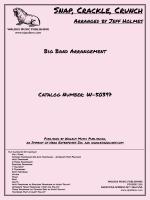SNAP, CRACKLE, CRUNCH [DOWNLOAD]
Arranged by Jeff Holmes

Cat #: W-50397-DL
$50.00This product is available for immediate download after purchase.
Questions?
Please call +1-518-587-1102 or email us.
Edition: Jazz Big Band Arrangement
Description: Swing - Difficult
Publisher: Walrus Music Publishing
Snap, Crackle, Crunch combines a medium blues big band shuffle with Thad Jones-like harmonies, rhythms and exuberant energy, with a number of stand-out features that set this chart apart. The piece begins with a full chorus of ad lib solo tenor (an AABA form where the As are 12 bar blues with an 8 bar B bridge) -- the first 24 alone – with crunchy brass hits at the end of each 12, then brushes join, another brass hit and bass join. The first 12 bar melody is played by alto 2, tenor 2 and trombones 1 & 2. The whole brass section then states the melody voiced. The bridge is a call and response between the brass and saxes, and the last A is handled by unison saxes with crunch in the rhythmic brass hits and a sendoff into an unimpeded tenor solo w/rhythm section. The blowing section can be repeated or played once with the only backgrounds on the bridge played by bass trombone and bari sax. The tenor solo ends with a 4-bar break followed by 24 bars of brass soli (trumpets on flugelhorns if available, otherwise play into stands or use bucket mutes).
The bridge section is a unison soli for bari, bass trombone, bass and tuba followed by 12 bars on ensemble shout. The tenor comes back on an improv bridge and a stop time 12 bar blues section which finishes with a bar of double time sax soli before returning to a voiced brass melody for 12. With a ½ step key modulation the saxes take over the melody with the brass 'crunch hits,' and yet another ½ step modulation with all the saxes collectively improvising against the brass until the tag ending with a brief bari/bass trb/bass/tuba moment and big ensemble finish. There is an abundance of specific articulations and performance concepts that are written into the parts and can be heard in the performance demo, however the chart should work without them as well. This is college and professional band territory but if your brass are hearty, can be looked at for high school as well. The sax parts are comparatively easier, and the piano and guitar even more so. A drummer with a good understanding of the stylistic intent is essential. Trombone 1 has especially demanding part in range and hearing the 'crunch' (often playing a major 7th below the lead trumpet), and Trumpet 1 will want to take advantage of optional tacet parts towards end for endurance purposes.
Soprano Saxophone (Or Alto Saxophone - Alternate Part Provided)
Alto Saxophone
2 Tenor Saxophones
Baritone Saxophone
4 Trumpets
3 Trombones
Bass Trombone
Guitar
Piano
Bass
Drums
Alto Saxophone or Baritone Saxophone as Guest Soloist
Alternate Tenor Saxophone 1 Part for Soloist
Tenor Saxophone or Trumpet Part as Guest Soloist
Trombone Part as Guest Soloist
Guitar Part as Guest Soloist
Trombone 1: Db5









